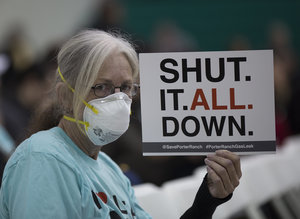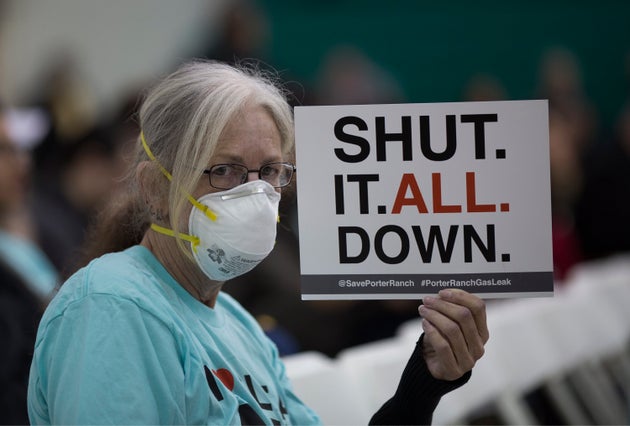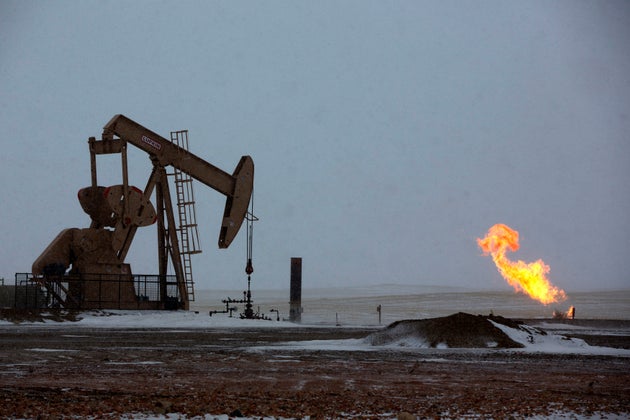THIS MAY BE THE BIGGEST ENVIRONMENTAL DISASTER NOONE IS TALKING ABOUT
HUFFINGTON POST

PORTER RANCH, CA – JANUARY 16: A woman holds a sign while attending a public hearing before the South Coast Air Quality Management District (AQMD) regarding a proposed stipulated abatement order to stop a nearby massive natural gas leak, on January 16, 2016 in Granada Hills, near Porter Ranch, California. More than 80,000 metric tons of methane gas have spewed from the Aliso Canyon natural gas storage facility since October 23, causing thousands of Porter Ranch residents to leave their homes, and the closures of two schools where students are being bussed to campuses farther away from the gas. State officials are now concerned that a seventh attempt to plug the well may have increased the chance of a blowout, which would greatly increase the release of gas as well as the risk of a massive well fire if ignited by a spark. The Southern California Gas Company (SoCalGas) hopes to repair the leak by sometime in March. (Photo by David McNew/Getty Images)
Researchers used infrared cameras to scan for methane gas leaks at over 8,000 U.S. sites.
The oil and gas industry has a major methane problem, according to an extensive environmental study.
Odorless, colorless methane gas is seeping out of wells and tanks at hundreds of natural gas facilities across the U.S., said the nonprofit Environmental Defense Fund, whose researchers used infrared cameras to scan for methane leaks at over 8,000 sites in the U.S.
They found hundreds of leaks scattered in an unpredictable pattern around the country, according to the study that the EDF published this month.
“The study confirms what previous studies were pointing to — that super-emitters are highly unpredictable, and that these leaks can happen anywhere, anytime, at large facilities and small facilities,” Matt Watson, associate vice president for the EDF’s climate and energy program, told The Huffington Post.
Methane, the primary element in natural gas, is a potent greenhouse gas and is responsible for 10 percent of total greenhouse gas emissions in the U.S. It packs 84 times more warming power than carbon dioxide in the first 20 years that it’s present in the atmosphere, according to the EDF. The environmental group estimates that reducing global methane emissions by 45 percent could have the same short-term benefit as shuttering 1,000 coal-fired power plants.
Natural gas releases less carbon dioxide than coal when burned, making it an attractive alternative to coal-fired electricity production. But methane leaks at gas facilities can cut into its advantage over coal, according to a report from the Smithsonian.
Oil and gas producers in the U.S., spew more than nine million metric tons of methane into the atmosphere every year, according to the EDF. Some of those emissions come from major leaks.
In February, seepage at the Aliso Canyon gas storage facility, near Porter Ranch, California, released roughly 100,000 tons of methane gas into the atmosphere before it was plugged. It was the largest methane leak in U.S. history.
The Aliso Canyon breach was an extreme example of a problem that affects natural gas storage facilities across the country, Mark Brownstein, the vice president of the EDF’s climate and energy program, told HuffPost in January.
The danger of large leaks is particularly pronounced at natural gas fields that have been converted into underground gas storage facilities, like Aliso Canyon, according to geologist Briana Mordick, a senior scientist at the Natural Resources Defense Council.
Despite the risks at large storage facilities, much of the country’s methane emissions come from small natural gas processing and storage plants, according to Watson. “This study has shown that you can have super emitter problems at small facilities,” he said.
The causes of methane leaks vary. Faulty equipment, shoddy maintenance and infrequent inspections can create seepages and allow them to persist. “[Inspectors] run across cases all the time where somebody’s just left a hatch open,” Watson said. “If you’re not out there looking for these things on a regular basis, you won’t see or smell these emissions.”
Some states have stepped up efforts to find and plug leaks. In 2014, Colorado became the first state to require oil and gas companies to fix seepages at their facilities. Colorado requires companies to capture 95 percent of their routine methane emissions. States like California appear to be following Colorado’s lead, as others race each to adopt stricter measures to prevent leaks, according to Watson.
But fixing the country’s scattered methane leaks will require federal laws mandating tougher and more frequent inspections of oil and gas facilities, Watson said. “Unfortunately, we have too few participants in the race, which is why, ultimately, you have to have a federal floor in place,” he said.
The American Petroleum the oil and gas industry’s main trade association in the U.S., said in a statement last year that the industry is taking steps to find and fix methane leaks. The API did not respond to a HuffPost request for comment.









Please update this article to reflect the far greater GHG impact on the atmosphere from Methane…as in 100 times the impact over the next few decades. Vs CO2.